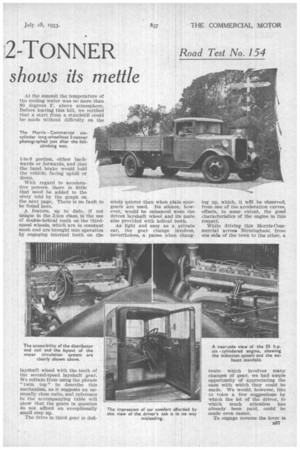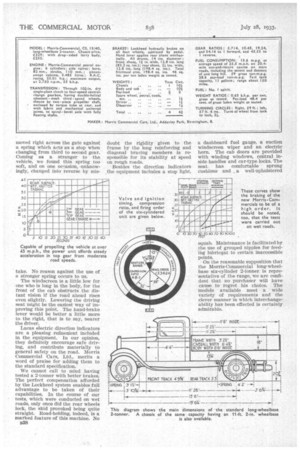A POPULAR BRITISH 2-TONNER
Page 54

Page 55

Page 56

If you've noticed an error in this article please click here to report it so we can fix it.
shows its mettle
WHETFIER four or six cylinders are the better proposition for a petrol-engined commercial vehicle is a vexed question. Morris Commercial Cars, Ltd., wisely realizing that the answer depends to quite a big extent upon personal opinion, or even fashion, has adopted the policy of making its whole range of chassis available with either type of power unit. Incidentally, it is thus all the better equipped to encounter competition.
The range of models is simple enough. It consists of 30-cwt., 2-ton and 3-ton chassis. The 2-tonner is made in :two wheelbase lengths, the dimensiOn of the short model being the same as that of the 30-cwt. chassis, whilst that of the long 2
tanner equals the wheelbase of the 3-ton model. The chassis (30-cwt. and 2-ton) In the short-wheelbase group are made with normal or forward control, the long 2-tonner, with normal control, and the 3-tonner with forward control only.
Except for a difference in backaxle ratio, every chassis is duplicated in so far as dimensions and power are concerned, but whilst one in each case has a six-cylindered engine, the other has a four-cylindered engine, both types of unit being of 25 h.p.
In the gear ratios we have, perhaps, the most convincing answer to the question a cylinder numbers. Thefl six-cylinder chassis have the higher ratio (5.7 to 1) for all except the 3-tonner, and the four-cylinder models have the lower ratio (6.5 to 1), except the 30-cwt.
Although 12 models are produced, ,only two engines, two wheelbases and two axle ratios are employed, consequently ' the number of interchangeable parts is unusually high. This point not only siinplifies rapid B36 and economical production, but also should make a strong appeal to owners of fleets of vehicles of different capacities. In the issues of The Commercial Motor dated March 3 and April 7 last full descriptions of the whole range of four-cylinder and six-cylinder chassis were published.
The long-wheelbase 2-tanner, as it were, bridges the gap between the short 2-tonner and the 3-tonner. It is with this model, with a six-cylindered engine, that our road-test report deals this week.
We have every reason to believe that the machine put at our disposal was a perfectly standard model, picked at random from stock. It had not even been fully run in on the road, having covered less than 50 miles when we took it over.
Our petrol-consumption test was carried out in two parts, and the figures published in the accompanying table are the results obtained over the total distance. The first run, during which a gallon of petrol was consumed, included the descent of Gorcott Hill, near Studley, on the Alcester road, which is somewhere about a mile long and has a gradient of approximately 1 in 12.
Climbing it on the return run, we were compelled, by reason of the gradient, to employ second gear, and for a short distance our sped fell to 10 m.p.h. Our average speed, however, for the first run was fairly high, being about 27 m.p.h., whilst the consumption was equal to 13 m.p.g. • ,
• The second test over a shorter and easier route, which was taken at an average of 22i -m.p.h., produced a figure of
15 m.p.g.
We started these tests with a cold engine, and its tenciperature was only 140 degrees F. at their conclusion. Furthermore, it must be remembered that it was not fully run in. Accordingly, we feel confident that better results could probably be obtained in actual service. Afterwards the carburetter was dismantled and its setting found to be as follows :—Main jet, 180; polver • jet, 35 ;.pilot jet, 14; and choke, 29.
An indication of the hill-climbing ability of the vehicle was obtained on Weatheroak Hill, just off 'the Alcester, road. It has a maximum gradient of about 1 in 8 and its total length is nearly half a mile. We• were able to average 15 m.p.h. up this slope, although on the steepest part, for which first .gear was needed, the speed was 8 M.p.h.
At the summit the temperature of the cooling water was no more than 80 degrees F. above atmosphere. Before leaving this hill, we verified that a start front a standstill could be made without difficulty on the
1-in-8 portion, either backwards or forwards, and that the hand brake would hold the vehicle, facing uphill or down.
With regard to accelerative. powers, there is little that need be added to the story told by the graph on the next page. There is no fault to be found here.
A feature, up to date, if not Unique in the 2-ton class, is the use of double-helical teeth on the thirdspeed wheels, which are in constant mesh and are brought into operation by engaging internal teeth on the layshaft wheel with the teeth of the second-speed layshaft gear. We refrain from using the phrase "twin top" to describe this mechanism, as it suggests an unusually close ratio, and reference to the accompanying table will show that the gears in question do not afford an exceptionally small step up.
The drive in third gear is deli nitely quieter than when plain spurgears are used. Its silence, however, would be enhanced were the driven layshaft wheel and its mate also provided with helical teeth.
As light and easy as a private car, the gear .change involves, nevertheless, a pause when chang
ing up, which, it will be observed, from one of the acceleration curves, offsets, to some extent, the good characteristics of the engine in this respect.
While driving this Morris-Commercial across Birmingham; from one side of the town to the other, a
route which involves many changes of gear, we had ample opportunity of appreciating the ease with which they could be made. We would, however, like to voice a few suggestions by which the lot of the driver, to which much attention has already been paid, couldbe made even easier.
To engage reverse the lever is 1137
moved right across the gate against a spring which acts as a stop when changing from third to second gear. Coming ag a stranger to the vehicle, we found this spring too soft, and on one ocmsion, unknowingly, changed into reverse by rais
take. No reason against the use of a stronger spring occurs to us.
The windscreen is a little low for one who is long in the body, for the front of the cab obstructs the distant vision if the road ahead rises even slightly. Lowering the driving seat might be the easiest way of improving this point. The hand-brake lever would be better a little more to the right, that is to say, nearer the driver.
Lucas electric direction indicators are a pleasing refinement included in the equipment. In our opinion, they definitely encourage safe driving, and contribute materially to general safety on the road. Morris Commercial Cars, Ltd., merits a word of praise for adding them to the standard specification.
We cannot call to mind having tested a 2-tonner with better brakes. The perfect compensation afforded by the Lockheed system enables full advantage to be taken of their capabilities. In the course of our tests, which were conducted on wet roads, only once did the rear wheels lock, the skid provoked being quite straight. Road-holding, indeed, is a marked feature of this machine. No B38 doubt the rigidity given to the frame by the long reinforcing and diagonal bracing members is responsible for its stability at speed on rough roads.
Besides the direction indicators the equipment includes a stop light,
a dashboard fuel gauge, a suction windscreen wiper and an electric horn. The cab doors are provided with winding windows, central inside handles and car-type locks. The seat. has comfortable sprung cushions and _ a well-upholstered squab. Maintenance is facilitated by the use of grouped nipples for feeding lubricarnt to certain inaeeessible points.
On the reasonable supposition that the Morris-Commercial long-wheelbase six-cylinder 2-tonner is representative of the range, we are confident that no purchaser will have cause to regret his choice. The models Available meet a wide variety of requirements and the clever manner in which interchangeability has been effected is certainly admirable.




































































































